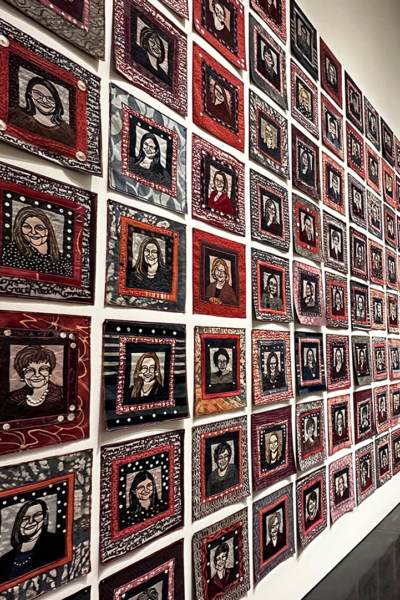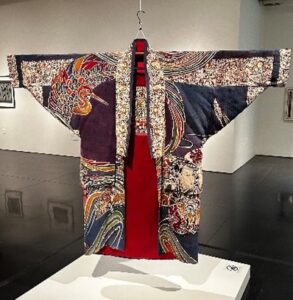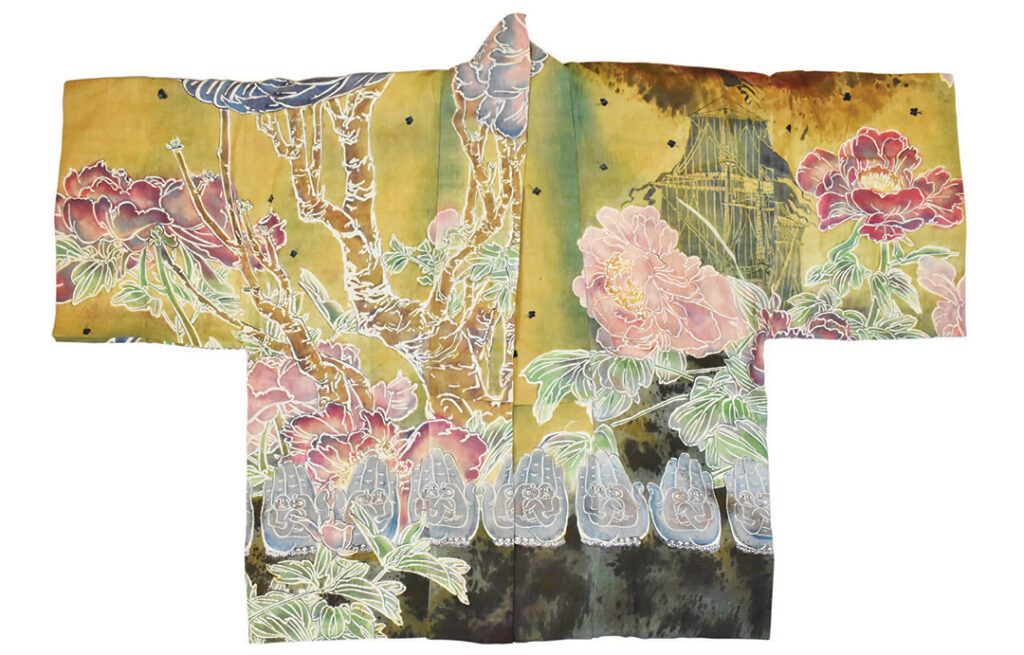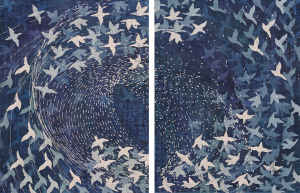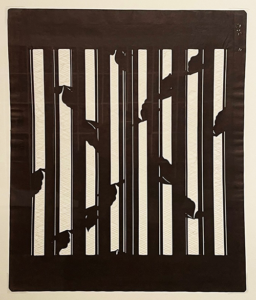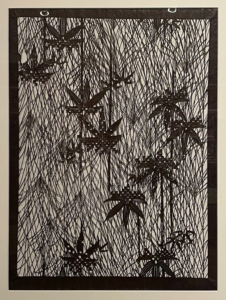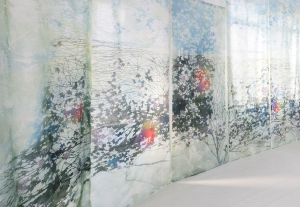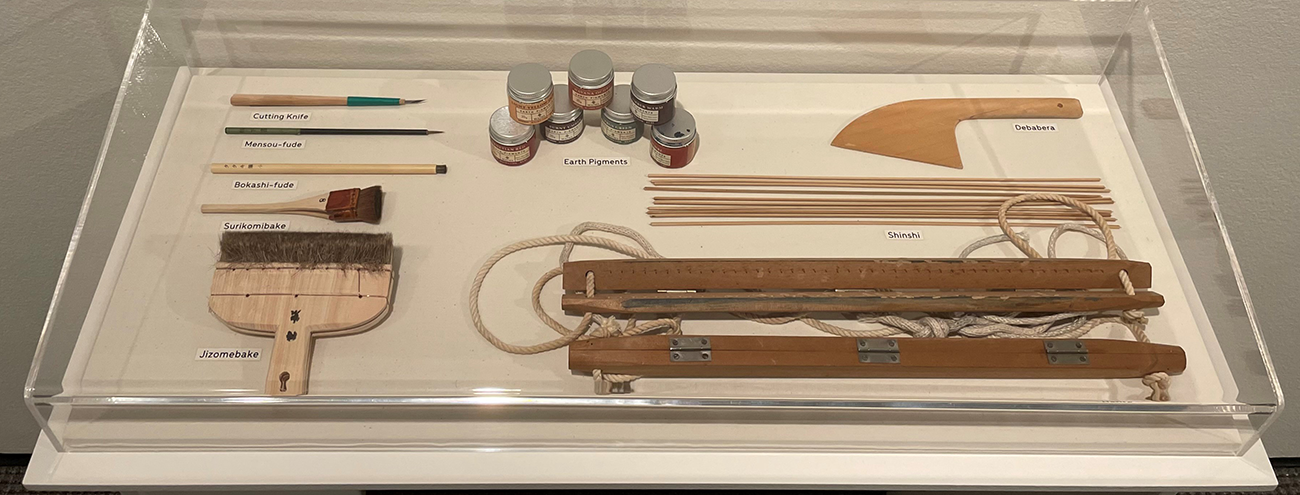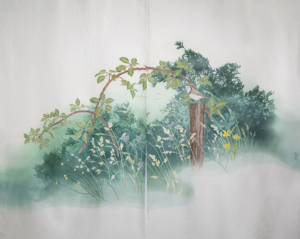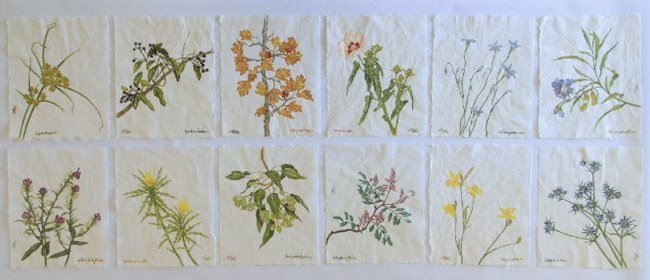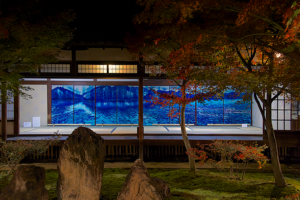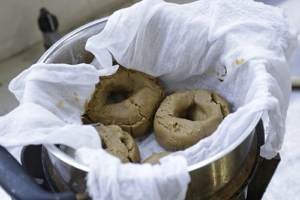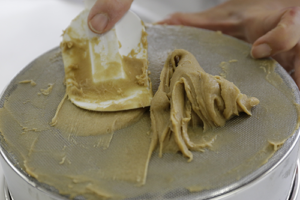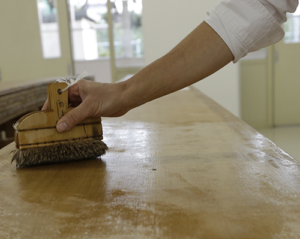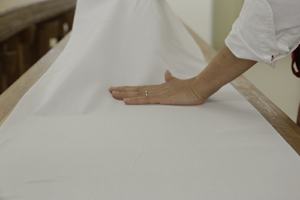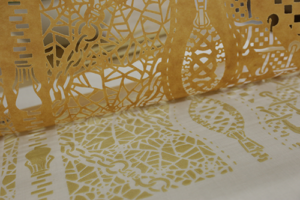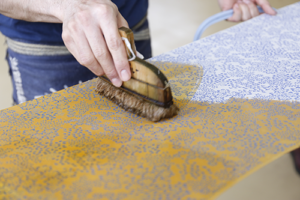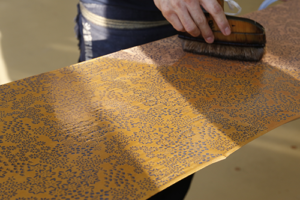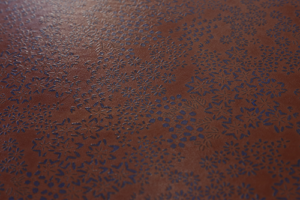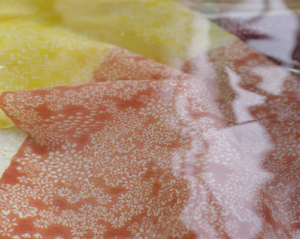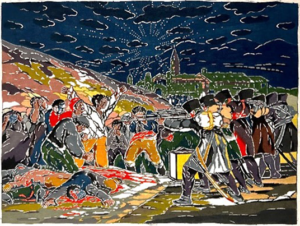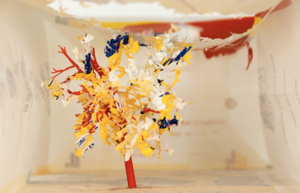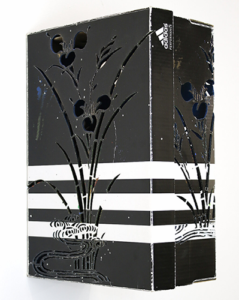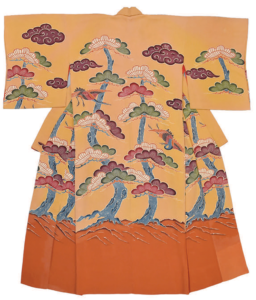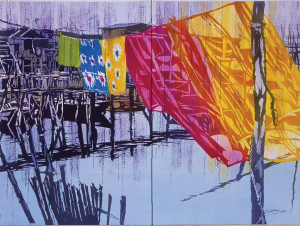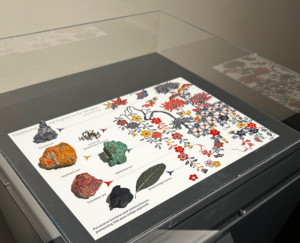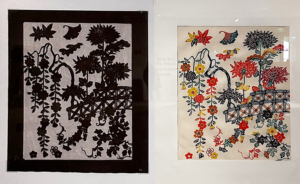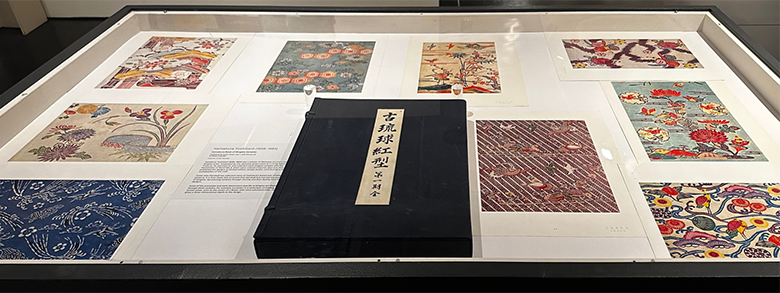Katazome Today: Migrations of a Japanese Art
Audio Guide
Introduction
Audio Recording
Katazome Today: Migrations of a Japanese Art
The world has become a much smaller place in the twenty-first century. Accelerated globalization has brought wide-ranging influences and ideas well within reach. With the speed at which information spreads, cross-cultural art forms (intangible cultural properties) also migrate and co-mingle across oceans and borders.
Katazome Today looks at the diaspora* of a unique and historically significant Japanese textile-dyeing process that informs the work of contemporary artists the world over.
The techniques of katazome and those of the intricately carved stencil papers, katagami, have been handed down through generations of artisans over several centuries. Traditionally used for kimono dyeing, katazome involves the application of a dye-resistant rice paste over hand-cut stencils to then dye fabrics.
With the influence of Western fashion and industrialized production processes, there is less demand for katazome products in Japan today. Fortunately, the traditional form is still practiced by artisans there. The technique continues to gain attention globally as contemporary artists explore katazome as a means of artistic expression.
In this exhibition, seven national and international artists share fresh perspectives on katazome through their current interpretations. With a range of pictorial imagery, they relate katazome to themes of personal identity, shifting environments, and globalization impacting the cultural landscapes of their home countries. Their works preserve an endangered traditional technique while envisioning endless possibilities for dynamic cultural exchange.
* Migration of a people or culture formerly concentrated in one place.
Katazome Today: Migrations of a Japanese Art was organized by the Whatcom Museum, Bellingham, Washington
Katazome Today is co-curated by Seiko A. Purdue, Professor in Fibers/Fabrics at Western Washington University, and Amy Chaloupka, Curator of Art at the Whatcom Museum. The exhibition was conceived by Seiko A. Purdue.
Support for Katazome Today is generously provided by Jean Andresen, the Whatcom Museum Foundation, the City of Bellingham, and the Whatcom Museum members. Funding for new work by Yuken Teruya is supported by Toshiaki Ogasawara Memorial Foundation. New work by Melinda Heal is supported by artsACT project funding from the ACT Government. Additional support provided by a City of Bellingham Tourism Promotion Grant. Media sponsorship provided by Cascade Public Media KCTS-9.
This exhibition at the Boise Art Museum has been made possible in part by a grant from the Idaho Humanities Council, the state-based affiliate of the National Endowment for the Humanities. Any views, findings, conclusions, or recommendations expressed in this exhibition do not necessarily represent those of the Idaho Humanities Council or the National Endowment for the Humanities.
Section Topic: Katazome
Audio Recording
History of the Craft
Katazome evolved around the eighth century as a wax-resist process called rokechi, which originated in China. By the sixteenth century, the adapted technique using rice paste had been perfected in Japan. The political and cultural isolation of the Edo period (1603-1868) and the relative peace and stability in Japan during that time allowed katazome to develop to its fullest.
Material choices and pattern motifs were refined and applied in specific ways to denote class and social standing. In general, katazome silk fabric was reserved for the elite, while shibori on cotton or hemp was designated for common classes.
By the end of the Edo period and through the Meiji period (1868-1912), Japan opened up trade with Europe. This resulted in the further spread of katazome fabrics and the patterned stencil katagami papers. The influence of katazome can be found in the pattern designs of the Arts and Crafts movement across nineteenth century Europe and the United States.
Variations of technique and style in paste-resist dyeing processes have advanced as technologies and innovations evolved over centuries. Tsutsugaki is a method of applying rice paste free-hand by squeezing it through a cone with a small metal tip. The yuzen technique developed in the early Edo period and was named after Kyoto fan painter Miyazaki Yuzensai. It is a layered process, originally accomplished with fine free-hand outlining (tsutsugaki with rice paste) and dye painting. In the 1870s, when chemical dyes became available, stencils (kata) were added.
Contemporary Katazome
Traditional forms of katazome and yuzen are still practiced in certain areas, such as Kyoto, Kaga, Tokyo, and Okinawa (where the style of katazome is known as bingata). However, due to modern technologies and the adoption of Western fashion, the processes and skills required to produce them are disappearing.
Keisuke Serizawa, a figure of the twentieth century folk-art movement called Mingei, helped revive katazome and bingata. Serizawa was ultimately designated a national treasure for his work.
During World War II, with much destruction in Okinawa, bingata techniques almost disappeared. Eiki Shiroma, a fourteenth generation practitioner of bingata, tracked down original stencils that had been sold on the mainland. In doing so, he brought the art back to life in Okinawa in the post-war years.
In recent decades, professors at Japanese art universities have incorporated katazome into their teaching. Through global dialogue between teachers and students, more and more contemporary artists are practicing katazome as a fine art process, much like painting or printmaking. Many of the exhibiting artists in Katazome Today have learned from one another or have shared their knowledge internationally.
As artists disseminate their knowledge and develop their own adaptations and new forms with this process, they present katazome on a world stage as a dynamic means of artistic expression.
Sources:
https://patternobserver.com/2015/01/20/history-surface-design-katagami-katazome/
https://en.wikipedia.org/wiki/Tsutsugaki
http://char.txa.cornell.edu/japantex.htm , primary source: Kax Wilson, A History of Textiles, (Colorado: Westview Press, 1979)
https://mingei.org/exhibitions/the-art-of-keisuke-serizawa
https://en.wikipedia.org/wiki/Bingata
Bincsik, Monika, Van Godtsenhoven and Masanao, Kimon Style: Edo Traditions to Modern Design: The John C. Weber Collection. (The Metropolitan Museum of Art, New York: Yale University Press, 2022)
Cheryl Lawrence, Women of the 116th Congress, 2019
Audio Recording
Cheryl Lawrence
Women of the 116th Congress, 2019
131 Stencil-printed, silk organza fabric, hand-dyed fabrics with thread, button, and beaded embellishments
Courtesy of the artist
In January 2019, Cheryl Lawrence was spurred to create this work in response to the largest number of women having just been sworn in to the United States Congress. She was also actively looking for a new project where she could work with the challenge of interpreting human faces through katazome.
Lawrence did not set out on this process as a solitary creative act. Similar to the traditions of quilting bees of the colonial era, her vision centered on the critical human need for community. She gathered a group of twenty women, friends and neighbors, in her studio, to work together. They lent their creativity and voice to each portrait through the addition of hand-stitched embellishments.
adjacent wall (top-bottom):
Hand-cut stencil, portrait for Women of the 116th Congress, 2019
Persimmon-soaked washi paper
Courtesy of the artist
Hand-cut stencil, text for Women of the 116th Congress, 2019
Persimmon-soaked washi paper
Courtesy of the artist
Women of the 116th Congress List
In order from left to right, top to bottom
Audio Recording
Row 1 (top row)
Lisa Murkowski (R) AK
Abigail Spanberger (D) VA
Martha McSally (R) AZ
Kyrsten Sinema (D) AZ
Dianne Feinstein (D) CA
Kamala Harris (D) CA
Mazie Hirono (D) HI
Joni Ernst (R) IA
Tammy Duckworth (D) IL
Elizabeth Warren (D) MA
Susan Collins (R) ME
Debbie Stabenow (D) MI
Amy Klobuchar (D) MN
Tina Smith (D) MN
Cindy Hyde-Smith (R) MS
Deb Fischer (R) NE
Maggie Hassan (D) NH
Jeanne Shaheen (D) NH
Catherine Cortez-Masto (D) NV
Jacklyn Rosen (D) NV
Kirsten Gillibrand (D) NY
Marsha Blackburn (R) TN
Maria Cantwell (D) WA
Patty Murray (D) WA
Tammy Baldwin (D) WI
Shelly Moore Capito (R) WV
Row 2
Martha Roby (R) AL
Terri Sewell (D) AL
Amata Radewagen (R) AS
Ann Kirkpatrick (D) AZ
Debbie Lesko (R) AZ
Grace Meng (D) NY
Nancy Pelosi (D) CA
Barbara Lee (D) CA
Jackie Speier (D) CA
Lucille Roybal-Allard (D) CA
Linda Sanchez (D) CA
Anna Eshoo (D) CA
Zoe Lofgren (D) CA
Katherine Hill (D) CA
Julia Brownley (D) CA
Judy Chu (D) CA
Grace Napolitano (D) CA
Norma Torres (D) CA
Jahana Hayes (D) CT
Eleanor Holmes Norton (D) DC
Karen Bass (D) CA
Maxine Waters (D) CA
Nanette Barragan (D) CA
Katherine Porter (D) CA
Susan Davis (D) CA
Diana DeGette (D) CO
Row 3
Rosa DeLauro (D) CT
Lois Frankel (D) FL
Debbie Wasserman Schultz (D) FL
Lisa Blunt Rochester (D) DE
Stephanie Murphy (D) FL
Val Demings (D) FL
Kathy Castor (D) FL
Abby Finkenauer (D) IA
Cindy Axne (D) IA
Robin L. Kelly (D) IL
Sharice Davids (D) KS
Jan Schakowsky (D) IL
Frederica Wilson (D) FL
Debbie Mucarsel-Powell (D) FL
Donna Shalala (D) FL
Lucy McBath (D) GA
Tulsi Gabbard (D) HI
Jackie Walorski (R) IN
Susan Brooks (R) IN
Chellie Pingree (D) ME
Lori Trahan (D) MA
Lauren Underwood (D) IL
Cheri Bustos (D) IL
Ayanna Pressley (D) MA
Elissa Slotkin (D) MI
Haley Stevens (D) MI
Row 4
Debbie Dingell (D) MI
Rashida Tlaib (D) MI
Brenda Lawrence (D) MI
Ann Wagner (R) MO
Katherine Clark (D) MA
Betty McCollum (D) MN
Ilhan Omar (D) MN
Angela Craig (D) MN
Debra Haaland (D) NM
Xochitl Torres Small (D) NM
Dina Titus (D) NV
Susie Lee (D) NV
Kathleen Rice (D) NY
Vicky Hartzler (R) MO
Virginia Foxx (R) NC
Alma Adams (D) NC
Ann McLane Kuster (D) NH
Mikie Sherrill (D) NJ
Bonnie Watson Coleman (D) NJ
Yvette Clarke (D) NY
Carolyn Maloney (D) NY
Alexandria Ocasio-Cortez (D) NY
Nita Lowey (D) NY
Elise Stefanik (R) NY
Kendra Horn (D) OK
Suzanne Bonamici (D) OR
Row 5 (bottom row)
Madeleine Dean (D) PA
Mary Gay Scanlon (D) PA
Chrissy Houlahan (D) PA
Susan Wild (D) PA
Elaine Luria (D) VA
Joyce Beatty (D) OH
Marcy Kaptur (D) OH
Marcia Fudge (D) OH
Jenniffer Gonzalez (R) PR
Elizabeth Pannill Fletcher (D) TX
Kay Granger (R) TX
Veronica Escobar (D) TX
Sheila Jackson Lee (D) TX
Sylvia Garcia (D) TX
Eddie Bernice Johnson (D) TX
Jennifer Wexton (D) VA
Carol Miller (R) WV
Stacey Plaskett (D) VI
Suzan DelBene (D) WA
Jaime Herrera Beutler (R) WA
Cathy McMorris Rodgers (R) WA
Pramila Jayapal (D) WA
Nydia Velazquez (D) NY
Kim Schrier (D) WA
Gwen Moore (D) WI
Liz Cheney (R) WY
Adjacent wall
Doris Matsui (D) CA (stencil)
John Marshall, Urashima Tarou-Coptic Maiwai, n.d.
Audio Recording
John Marshall
Urashima Tarou-Coptic Maiwai, n.d.
silk, natural dyes, compound stencils
Courtesy of the artist
Marshall uses the canvas of wearable kimono to communicate both contemporary and traditional themes. One ancient tale he references is that of Urashima Tarō. Based on an eighth century Japanese folk tale, Tarō is a young man who saves a sea turtle from harm and whose good deed is rewarded with an invitation to the depths of the ocean by the princess of the undersea palace Ryūgū-jō.
Marshall relays the tale on the form of a maiwai kimono. A ceremonial robe originating from Chiba, Japan, maiwai often feature brightly illustrative designs in a narrative format. They are traditionally given to fishermen as a celebratory reward for a large catch. Marshall loves to reference Japanese textile traditions and style but also enjoys deviating from the rules. Here, that means adding the Coptic saint Titus to the story. The inclusion of the Roman Catholic saint represents the creative spirit and serves as a reminder to allow space for free thinking.
John Marshall, Angel in the Garden, 2021
Audio Recording
John Marshall
Angel in the Garden, 2021
Natural pigments and vegetable dyes on
Chinese cannabis
Courtesy of the artist
Raised in Florin, California, John Marshall’s grade-school teacher and godmother was a Japanese-American woman named Mary Tsukamoto. She nurtured an early interest in Japanese-influenced culture for Marshall, which set him on a trajectory of further learning in Japan. In 1972, at the age of seventeen, he began studying the traditional techniques of katazome in Japan. His apprentice there was Matsuyo Hayashi, a master of bingata dyeing. Through decades of exploration, Marshall is now internationally recognized for transforming traditionally inspired aesthetics into contemporary, wearable artworks.
Marshall has carved more than a thousand stencils and has inherited a great many more from teachers and classmates in Japan. Thus, he draws from a vast visual language to create stencil-dyed textiles. Angel in the Garden displays a joyous array of iconography from interests including religious, figurative, folkloric, and personal experiences. It’s no surprise Marshall features gardens in his work. At his property in California, he grows a range of plant matter from which he produces his natural dyes, including indigo plants, plum trees, and more.
Cheryl Lawrence, Snowstorm, 2011
Audio Recording
Cheryl Lawrence
Snowstorm, 2011
Katazome with indigo pigment on silk
Courtesy of the artist
Cheryl Lawrence has practiced katazome for more than three decades and often draws inspiration from the natural world for her pattern designs. Here she was inspired by the synchronized scatter of a flock of snow geese, a site she witnessed firsthand in the winter farmlands of Skagit Valley.
The work was achieved through several processes unique to katazome. Lawrence applied rice paste through her stencil to create the whitest birds in the foreground first, then built the design with successive layers of brushed-on indigo pigment, alternating with additional layers of paste. This allowed each layer to further darken toward the background, creating depth in the piece.
She also used tsutsugaki, a technique to apply rice paste free-hand through a bag with a cone tip, much like decorating a cake. However, Lawrence developed an innovative way of applying the pattern by swinging the bag from a rope above the piece, allowing the paste to drip in an energetic spray pattern.
Unknown carvers, Traditional Katagami stencils, c. late 1800s to early 1900s
Audio Recording
Unknown carvers
Traditional Katagami stencils, c. late 1800s to early 1900s
persimmon-soaked washi paper, hand-cut
Collection of Seiko Purdue, gift of Carol Carlson
These finely-executed, punch-carved patterns are examples of komon design. Some komon patterns can be so small they are nearly invisible to the eye. The dyed effect of komon gives a soft-focused, shimmering surface to the fabric.
Komon patterns were intended to mimic more costly woven and dyed processes, such as ikat and shibori, and the dotted texture of sharkskin leather. These were materials and processes available only to the wealthy classes. Katazome using komon patterns eventually became exclusive wear as well, due to their intricacy, and were primarily worn by samurai and merchant classes.
Section Topic: Katagami
Audio Recording
Katagami: Art of Stencil Carving
For centuries, people in Japan have applied patterns to kimono cloth using hand-carved stencils called katagami. Kata in Japanese means stencil, and gami means paper. Katagami are the primary tools in the katazome dye process, but the delicate, hand-carved mulberry-paper stencils are seen today as works of art unto themselves.
Jigami
The papers used to make katagami are called jigami and take about forty days to produce, with many steps involved. This includes layering the mulberry washi papers, laminating them with persimmon juice tannins for strength and waterproofing, then smoking the papers with cedar for weeks to cure them. This treatment makes the paper durable for both carving and repeated use.
Stencil Carving
Separate from the jigami makers are the craftspeople who carve the stencils. The carving of katagami is said to date back to the Heian period (794-1185) and flourished in villages around Ise Bay during the Edo Period (1603-1868). The craft was regionally specific and became known as Ise katagami. Even today, around ninety-percent of katagami used for dyeing are still made in what is now known as Mie Prefecture.
Influence of Katagami
In the nineteenth century, when Japan opened up to trade worldwide, European and North American museums collected katagami papers, appreciating them for their inherent artistry and dynamic designs. These patterns also influenced the Western Arts and Crafts Movement and katagami-related designs appeared in jewelry, furniture, wallpaper, and other applied arts. Even the development of the silkscreen process can be traced back to katagami.
Cultural Treasure
World War II (or the Pacific War, as it is known in Japan), brought a decreased workforce and changes in the culture of clothing in Japan, resulting in the decline in the production of katagami. By the 1950s, the government, wanting to preserve the cultural importance of katagami, designated individuals in the field as Living National Treasures. This boosted the demand for kimono fabric through the 1960s. Today, katagami is seen as an important Intangible Cultural Property in Japan, but falling market demand for dyed kimono place the future of this craft at risk. There are only a handful of skilled carvers working in its traditional forms today.
Contemporary Katagami
While skilled practitioners have diminished in numbers, contemporary artists are adopting the process in the creation of their artworks.
Today, artists develop their designs, cut the stencils, select the dyes, and print their own fabrics and papers. This gives them creative control and freedom to manipulate aspects of the process. Often, the finished works are not in the form of utilitarian clothing or wallpaper, rather, they take on many different forms and convey a wide range of content as contemporary works of art.
Sources:
https://isekatagami.or.jp/en/en_history/
Iwao Nagasaki, Akiko Mabuchi, and Nao Aoki, “Ise Katagami: the Exquisite Art of Stencil Carving,” in Approach Magazine, (Winter 2021)
Eisha Nakano with Barbara B. Stephan, Japanese Stencil Dyeing (Colorado: Weatherhill), 1982
Unknown carvers, Traditional Katagami stencils, c. early 1900s
Audio Recording
Unknown carvers
Traditional Katagami stencils, c. early 1900s
persimmon-soaked washi paper, hand-cut
Collection of Seiko Purdue, gift of Carol Carlson
Nature motifs are abundant in Katagami patterns. Beyond decoration, they convey varying messages, from wishes of good fortune to expressions of resilience or new beginnings. Cranes, swallows, sparrows, rabbits, and carp all feature in lyrical designs. Floral motifs include maple leaves, cherry blossoms, pine trees, bamboo, peonies, and irises. Wisteria, butterflies, and chrysanthemums are featured in this selection of stencils from the early twentieth century.
The chrysanthemum, or kiku in Japanese, is a popular katagami motif. An autumnal flower that symbolizes goodwill and longevity, it is also an emblem of the Imperial family and features on royal seals and the Japanese throne.
Unknown carvers, Traditional katagami stencils, c. 1920
Audio Recording
Unknown carvers
Traditional katagami stencils, c. 1920
persimmon-soaked washi paper, hand-cut
Collection of John Marshall
To create a variety of intricate patterns, Ise katagami involves four, distinct stencil-carving methods produced with special knives and chisels:
tsukibori push-carving
kiribori drill-carving
dogu-bori punch-carving
shimabori stripe-carving
Finely detailed patterns that look pointillistic are called komon and larger figurative or geometric designs are called chugata.
Designs with large, open spaces require reinforcing in order to stand up to repeated applications of rice paste through the stencil. Itoire is a method of sandwiching fine silk threads into the sheets of mulberry paper to stabilize the stencil pattern so that it does not tear.
Several examples in this grouping have visible itoire threads supporting the delicate patterns. Invented more recently, shabari is a method that involves pasting a fine, silk gauze backing to the stencil for overall support. Often, the design itself will incorporate clever ‘bridges’ and ‘joints’ to link elements of the pattern together for increased stability.
Unknown carver, Traditional katagami stencil, c. 1920
Audio Recording
Unknown carver
Traditional katagami stencil, c. 1920
persimmon-soaked washi paper, hand-cut
Collection of John Marshall
When Japan opened up its trade with Europe in the 1850s, crafts like katagami, became immensely popular and were widely collected. By the late nineteenth century, the rhythmic stencil designs had a huge impact on the Arts and Crafts and Art Nouveau movements throughout Europe and the United States. Illustrators and designers like Walter Crane, William Morris, Louis Comfort Tiffany, and René Lalique took cues from the underlying principles of Japanese art—simplicity, purity of form, and a strong affinity for nature, the essence of which can be seen in wallpaper designs, jewelry, furniture, and more from this era.
Akemi Nakano Cohn, Cycle of Renewal #4, 2014
Audio Recording
Akemi Nakano Cohn
Cycle of Renewal #4, 2014
Japanese rice paper dyed with indigo and natural dyes and Kakishibu, hand-cut and constructed
Courtesy of the artist
Akemi Nakano Cohn uses the katazome process to create works of layered fabric with hand-made paper. For Cohn, her processes and chosen materials are tied to concepts of cycles, regeneration, memories, and the trace of an experience. Part of the paste-resist dye process she uses includes hand-cutting her stencil designs into specific patterns to compose and transfer an image onto fabric. The negative spaces in the katagami stencils have become a source of inspiration for Cohn.
In this piece, she foregrounds the stencil-cutting process by carving the pattern directly out of hand-dyed rice paper. Instead of using the stencil as a tool to create the work, the cut paper is folded into the finished piece. The cut areas indicate the trace of a creature’s existence. Cohn describes this as “evidence of creating a memory.”
Akemi Nakano Cohn, Place to Return #2, 2022
Audio Recording
Akemi Nakano Cohn
Place to Return #2, 2022
Katazome and Tsutsugaki, rice paste resist printing technique with natural dyes and mineral pigments on silk
Courtesy of the artist
Akemi Cohn frequently returns to the elemental form of the circle to visually describe a return to the beginning. This can be seen in her work Place to Return #2 and is an idea she reflects on within her decades-long practice. Since first learning katazome over forty years ago in Japan, and now living in the United States, where she explores her artistic ideas through this process, she describes the feeling as being like a ship returning to the original port after a long journey. “Even though I stand on the starting point where I left for an adventure, I am no longer the same as I was because of my life experiences.”
Fumiyo Imafuku, Cycle of Time – Music is to rain down from Heaven, 2016
Audio Recording
Fumiyo Imafuku
Cycle of Time – Music is to rain down from Heaven, 2016
Silk organza, katazome, original technique, natural dyes (including Lac, cochineal, Suzhou, Kariyasu, Kihada, Enji, rice, pomegranate, golden flowers, Tinchi, Shibuki)
Courtesy of the artist
The inspiration for this piece stems from Imafuku’s memory of walking her young son in a stroller through Kyoto’s Gion Festival at dusk. She recalls the sound of the music raining down from the floats above, and her sons’ eyes transfixed on the bobbing tassels of the musicians’ costumes. Her piece echoes with the vibrant reflections of this memory. The rhythmic folds of the silk organza wash over the viewer in repeated waves.
The history of the Gion festival, which dates to the year 867, also holds deep significance for Imafuku, as it represents both a legacy of trade and dyeing traditions in Japan. She explains:
“I imagine that the dyed and woven textiles that decorate the Gion Festival are a history of the splendid fusion of goods brought across the sea and dyed and woven textiles made in Japan…The red lac dye used in this work is said to have been widely used for yuzen and Japanese chintz in the Edo period (1603-1867), and is probably the same dye used in many of the floats at the Gion Festival. For me, the use of natural dyes is an act that is connected to historical memories.”
Akemi Nakano Cohn, Cycle Series: Return, In Blue, Trace, Fragments, New Soil, 2022
Audio Recording
Akemi Nakano Cohn
Cycle Series: Return, In Blue, Trace, Fragments, New Soil, 2022
Natural Indigo dyeing on ramie, katazome rice paste resist technique with mineral pigments
Courtesy of the artist
The five panels that make up the Cycle Series, are oriented in a format similar to Japanese picture scrolls. The artist states that the piece was inspired by Buddhist belief in life cycles. The katazome process is ideal for communicating a visual representation of the cycling of life and death, as a defining element of the technique is the repeating of pattern.
After the artist printed the images with earth pigments on the natural fiber ramie cloth, each piece was dipped into a natural indigo dye bath. Various shades and saturations of indigo blue recall waves of the ocean, or a flow of water, adding to the cyclical movement of the piece. The long, linear format reinforces the idea of time passing.
Fumiyo Imafuku, Cycle of Time – Memory of Place, 2014
Audio Recording
Fumiyo Imafuku
Cycle of Time – Memory of Place, 2014
Cotton, silk organza
Katazome, original technique, chemical dyes
Courtesy of the artist
Fumiyo Imafuku’s work pushes against traditional katazome forms, stretching both scale and scope to become what she calls “space compositions.” Responsive to architecture and generating their own environments, her dyed works push the boundaries of possibility for the process.
For fifteen years, the artist has explored the theme of the Cycle of Time through her investigations, spurred by the writings of poet Sensei Yamao (1938–2001). The poet describes time as a concept outside the traditional bounds of linear thinking of past-present-future, opening up notions of time as a repeating current, such as the cycle of the seasons. Here the growth of ivy represents the passing of time as it climbs and stretches in all directions across and up the panels of silk.
Cheryl Lawrence, Untitled (katazome stencil, peony design), 2011
Audio Recording
Cheryl Lawrence
Untitled (katazome stencil, peony design)
persimmon-soaked washi paper, hand-cut
Courtesy of the artist
Assorted tools for the katazome process
Audio Recording
Assorted tools for the katazome process
Tools courtesy of John Marshall
Pigments courtesy of Cheryl Lawrence
Starting from left front corner, clockwise:
Jizomebake: a brush used to apply large swaths of color and used primarily for applying dyes to the background.
Surikomibake: a smaller brush used to apply color to more isolated areas
Bokashi-fude, (also known as tataki-fude): used to apply shadings and accents in bingata
Mensou-fude: a tool used to brush in small details and repair miss-dyed areas
Cutting Knife: used to carve stencils. The forged-steel blade is sandwiched between two slats of bamboo and held together with a silk cord. As the blade wears down through sharpening, the blade is advanced.
Earth Pigments: when mixed with a soy milk binder they are used to dye fabrics a variety of colors.
Debabera: a spatula used to push rice paste through the stencil and onto the fabric
Shinshi (set of ten): bamboo skewers with needles in each end. They are flexible and poke into the fabric edges to stretch the fabric for a workable surface.
Harite: clamps used with shinshi to stretch and suspend the fabric for painting. The clamps are used for biting into the yardage lengthwise on each end, much like hanging a hammock, as shown here.

Image courtesy of Cheryl Lawrence
Section Topic: Katazome | Paste-Resist Stencil Dyeing Process
Audio Recording
Katazome: Paste-Resist Stencil Dyeing Process
Katazome is a kimono fabric dyeing technique used in Japan since the eighth century. It is one of several methods for dyeing fabric using a resist process; along with shibori, a bound-resist commonly known as tie-dye, and batik, which employs a wax-resist.
Precision and Repetition
The word katazome is derived from a combination of two Japanese words: kata meaning stencil and some/zome meaning dye. It refers to the process of applying a water-soluble paste-resist through a cut stencil design in order to dye fabric with detailed patterns. Katazome is defined by qualities of precision and repetition. Durable stencil paper, specific tools and equipment, the perfect consistency of rice paste, and the maker’s exacting skill and care come together in a process refined and handed down through generations.
Technique and Process
The paste-resist is made from steamed rice flour and rice bran. The paste is applied to the fabric with a squeegee through the stencil. After the paste dries, sizing (soymilk/seaweed) is applied to the fabric to help bind the colors (dyes) to the fibers. Next, the dye is applied with brushes and then steamed to permanently fix the dyes. Afterward, the paste and excess dye are rinsed off with water. Depending on the type of dye and complexity of the design, this process may be varied and repeated multiple times in the creation of one piece.
Traditional Katagami
The traditional hand-cut stencil papers used in this process, called katagami, are a work of art in their own right. Made of mulberry paper, they are layered and glued together, treated with persimmon juice, and then smoked to make them water-resistant and to hold up to repeated use.
Though katazome processes are very specific on one hand, there are also many variations and adaptations along the way. Katazome artists enhance their creations through the use of synthetic or natural dyes, pigments, or types of fabrics.
Sources:
https://ja.wikipedia.org/wiki/%E5%9E%8B%E6%9F%93%E3%82%81
https://kirikomade.com/blogs/our-fabrics/15314847-katazome
Sunny Yang and RoChelle M. Narasin, Textile Art of Japan, (Japan Publications, 1989)
https://www.takenaka.co.jp/takenaka_e/library/pr_magazine/2021win/book/html5.html#page=9
Melinda Heal, Complex edges – the Molonglo River, 2022
Audio Recording
Melinda Heal
Complex edges – the Molonglo River, 2022
Katazome on tsumugi silk with acid dyes
Courtesy of the artist, with support from ArtsACT, ACT Government

Heal’s research into natural environments has led her to examine areas of vegetation that thrive on the margins of urban and suburban spaces. Here she explores the complex ‘edges’ of the Molonglo River. An area that meanders through the center of Canberra, Australia, it was partially dammed in the 1960s to form Lake Burley Griffin. The area is now heavily used for recreation, though it remains an important freshwater sanctuary for migratory birds. Heal is intrigued by such “messy, complex ecosystems,” and pictures a vignette where native grasses and bluebells intermingle with invasive blackberries and a seasonal visitor, the White-fronted Chat.
The work also alludes to a popular Japanese art trope through its styling and approach. Akikusa is a term that translates to “the grasses of Autumn.” It’s a motif featured in paintings depicting wind-blown and withered autumn plants meant to evoke a wistful appreciation of impermanence. Heal communicates these ideas through the local species and cycles of the Australian landscape.
Melinda Heal, Beautiful Plants of Canberra, 2022
Audio Recording
Melinda Heal
Beautiful Plants of Canberra, 2022
Katazome-dyed kozo washi Natural pigments
Courtesy of the artist, with support from ArtsACT, ACT Government

Heal has spent years investigating the idea of weeds through intricately observed plant portraits. She first began scrutinizing her own biases when she realized she was editing out many non-native plants in an attempt to portray a ‘perfect’ Australian landscape. Over time, she came to appreciate that many invasive plant species were aesthetically intriguing, and she marveled at how seamlessly they commingled with the native grasslands of the area.
For Beautiful Plants of Canberra, Heal examines the idea of ‘the weed’ as a human construct, intermixing portraits of weeds and natural plants found in her local surroundings. She observes and composes each portrait with equal care and attention through the katazome process, noting that they are all beautiful to look at, with unique forms, colors, and textural detail.
Akemi Nakano Cohn, Cycle/Seeds, 2022
Audio Recording
Akemi Nakano Cohn
Cycle/Seeds, 2022
Japanese rice paper dyed with natural indigo and painted with natural dyes, hand-cut
Courtesy of the artist
Cohn uses a variety of natural materials which she processes into dyes. Indigo, which comes from plant matter, gives a rich, blue tone, and is a dominant hue in her work. Walnut produces an earthy tone and Kihada, which comes from the bark of an amur cork tree, produces a vivid yellow dye. Kakishibu (“柿 KAKI is a persimmon, 渋 SHIBU means astringent), comes from persimmon tannin, giving an amber tone. The intricate, hand-cut spray of dots scattered across the surface of the piece mimics the tossing of seeds during times of sowing.
Cohn’s use of natural dyes directly reflects her ideas of capturing fleeting memories, such as the bloom of a flower. She states, “flowers are ephemeral and they live only a short time. Dyes extracted from live flowers, plants, and roots such as marigold, weld, osage, black oak, madder, walnuts and more will stay on the fabric as extracted color. Even though the flowers are gone, the color will stay on as a dual existence. The color on fabric indicates a memory.”
Melinda Heal, The Cliffs, they are breathing, 2022
Audio Recording
Melinda Heal
The Cliffs, they are breathing, 2022
Katazome on tsumugi silk with acid dyes
Courtesy of the artist, with support from ArtsACT, ACT Government

To date, this is the largest and most ambitious work Melinda Heal has realized through the katazome process. The imagery is based on beachside cliffs located in the coastal town of Bermagui, in southeastern Australia. Her depiction of the scene at this scale expresses the awe and grandeur she feels when standing before these natural formations. She describes, “…these spectacular orange cliffs ripple their way along the coast, displaying their geological lines clearly. This sense of movement in something so ancient and solid was what initially inspired me to dye this landscape.” Embedded into the fibers of flowing bolts of silk, the dynamic scene is activated through the graceful movement and flow inherent to dyed textiles.
Video | Creating a Zen World
Audio Recording
Creating a Zen World: The Katazome Art of Mika Toba
Film, run time: 45 minutes
Produced by NHK in association with JIB and in cooperation with TVing
Used for educational purposes with permission from NHK Media and the artist
Cheryl Lawrence, Mandala Tiles, 2010
Audio Recording
Cheryl Lawrence
Mandala Tiles, 2010
Limestone
Courtesy of the artist
Lawrence brings a sense of experimentation and an understanding of chemistry to her practice time and again, working with unconventional materials, beyond cloth. Sometimes she does this through works that are architectural in nature. She has worked her katagami stencil patterns into tile designs, using natural dyes such as indigo and iron ore on limestone, and etching solutions on copper and steel. These are then composed and installed permanently in interior spaces as bathroom walls, floors, and fireplace surrounds.
Interpretive Panel: Process
Audio Recording
Rice-paste making for katazome
Rice flour (mochiko) and rice bran (nuka) are mixed, and water is added. This is slowly kneaded to form dough balls.
Dough is shaped into donut-like rounds and steamed for half an hour or cooked in boiling water for 6-to-8 minutes.
After steaming/cooking, the dough is mixed with a mortar (suribachi) and pestle (surikogi). Water and a little salt is added. Once the paste is thinned to correct consistency, it is ready.
Very thin paste is brushed onto a flat wooden table or board to glue the fabric down. The scoured fabric is stretched over the wood and smoothed flat.
Paste application and color application using natural dyes
After the stencil is cut and prepared, it is placed on the fabric and secured in place with pins or tape. A consistent layer of rice paste is applied over the stencil with a squeegee. The stencil is slowly removed from the fabric and the paste is allowed to dry.
After the fabric is sized with soy milk, it sets for 3-to-5 days. Natural dyes are prepared and applied to the fabric using a brush. Once the fabric is left to dry after dyeing, it is brushed with mordant.
The fabric is soaked in a tub of water to soften the paste; then paste and extra dyes are rinsed off in several washes to reveal the resisted designs.
All images courtesy of Fumiyo Imafuku
Photos: Ryoichi Hiromoto
Cheryl Lawrence, Untitled Tile Samples, 2010
Audio Recording
Cheryl Lawrence
Untitled tile samples, 2010
Limestone, natural dyes
Courtesy of the artist
Mika Toba, Wandering in the Medieval Time, 2006
Audio Recording
Mika Toba
Wandering in the Medieval Time, 2006
Silk
Courtesy of the artist
Katazome is uniquely specific to Japan. Artisans there have refined the practice over centuries, working with the materials and climate the region has to offer. Particular ingredients, such as rice bran to make the resist paste, and soy for the binders, are all abundant in Japan. As such, it is rare to see traditional katazome expressed in certain parts of the world where these resources are hard to access.
Through her travels, Mika Toba resolves these limitations by capturing global settings through photography, and conveys them through katazome upon returning to her studio in Japan. The results are evocative pictorial scenes interpreted through the roughly 18-stages of the stencil-dyed process.
This piece gives a glimpse into Toba’s travels to Fez, Morocco. She describes the Sahara Desert as a complete contrast to the humid and lush scenery of East Asia, which has inspired her work for decades. Exploring the labyrinths of alleys that crisscross through Fez, Toba felt as if she was immersed in a medieval time outside of her own.
Yuken Teruya, The Third of May 1808 at Bingata gaze, 2022/23
Audio Recording
Yuken Teruya
The Third of May 1808 at Bingata gaze, 2022/23
Bingata dyed linen
Courtesy of the artist, supported by Ogasawara Foundation

A detail in Yuken Teruya’s piece, Parade From Far Far Away, reveals a reproduction of Francisco Goya’s painting, The Third of May 1808, in the form of a banner being hoisted into the air in the long procession.

The artist revisits this painting in the creation of a new bingata piece. The Third of May 1808 is said to commemorate Spanish resistance to Napoleon’s armies. A man dressed in white bravely stands with his bare hands to the sky, defenseless to the army. This work of art has stuck with Teruya since he was first introduced to it in high school art class. He states, “In contemporary society, we witness the same scenes occurring, where armies and those in power confront unarmed civilians. By including this historical reference to European art history, my intention is to invite viewers to make additional connections between Okinawan history and the history of their own home countries.”
Yuken Teruya, Parade From Far Far Away, 2014
Audio Recording
Yuken Teruya
Parade From Far Far Away, 2014
Bingata technique on linen
Courtesy of Piero Atchugarry Gallery, Miami
This work is created in the traditional Okinawan style of katazome, called bingata. Katazome is typically dyed in long bolts of fabric. This format, called tanmono, is the yardage required to assemble a complete kimono. The long, linear orientation of the tanmono suits the scene of a long parade making its way across the wall.
The joyful procession shows the fictional imagining of Okinawa’s festival of unity. Believing that a vision of the future relates to an understanding of the past, Teruya depicted more than 110 participants in the parade. Most of the figures are portraits of actual people from the past and present including Okinawan politicians, writers, artists, dancers, musicians, activists, friends, and family members. It celebrates the resilience and aspirations of a people who have overcome hundreds of years of oppression from Japanese rule and American occupation.
Yuken Teruya, Billowing, 2013
Audio Recording
Yuken Teruya
Billowing, 2013
Bingata dyed linen
Courtesy of the artist
Yuken Teruya works with a variety of materials and processes from transforming everyday objects such as McDonald’s paper bags, leaves, newspapers, and Monopoly™ money into intricate, hand-cut sculptures, to conceptual video works related to his cultural homeland of Okinawa. His kimono works, such as the piece Billowing, are made using the Okinawan style of katazome, called bingata.
Teruya’s style and processes are traditional, and represent a voice from the past, when Okinawa was the Ryukyu kingdom. However, the content of Teruya’s stencil patterns reveals contemporary messages that communicate the complex dynamics of Okinawa as it exists today. Imagery such as American fighter jets and children carrying balloons intermingle with traditional bingata motifs, such as flowing rivers, iris flowers, and swallows. The overall composition conveys the impacts of Japanese imperialism and U.S. military occupation while centering Okinawan culture. The piece speaks to the resilience of the Okinawan people to maintain their cultural heritage throughout centuries of colonialism.
Yuken Teruya, Golden Arch Parkway McDonalds
Audio Recording
Yuken Teruya
Golden Arch Parkway McDonalds Blue Tree, 2005
McDonald’s paper bag and glue
Courtesy of Piero Atchugarry Gallery, Miami
Yuken Teruya
Golden Arch Parkway McDonald’s (Red Yellow), 2005
McDonald’s paper bag and glue
Courtesy of Piero Atchugarry Gallery, Miami
These two works are part of a larger series titled Notice-Forest, that Teruya has expanded upon since 1999. Made from a variety of shopping bags from global corporations like McDonald’s, Tiffany and Co., and Gucci, the works comment on the rampant growth of consumerism in contemporary society, as well as the depletion of natural resources required to feed the insatiable desire for such products.
Drawing on his experience in cutting intricate katagami papers for his bingata stencil patterns, Teruya hand-carved these delicate trees directly from the walls of the paper bags themselves. Here, the tree becomes paper, paper becomes bag, and bag returns back to its original form of a tree.
Yuken Teruya, My Vote series
Audio Recording
Yuken Teruya
My Vote series (Puma), 2009
Shoe box
Collection of Thomas Talucci
Yuken Teruya
My Vote series (Adidas), 2009
Shoe box
Collection of Thomas Talucci
Though originally from Okinawa, Yuken Teruya lived in New York City for much of the last two decades. He synthesizes his experiences of living in a western, capitalist society with his upbringing in Japan. With these two works, he melds culturally contrasting imagery through his stencil carving. Typically, the artist carves katagami stencils from washi paper to create his bingata patterns. The end results are seen in hand-dyed fabric works incorporating these designs.
Here, Teruya chose to carve his stencil patterns from the surfaces of found-cardboard sneaker boxes. In addition to traditional motifs like irises and chrysanthemums are elements of contemporary consumerist society, such a deli coffee cup design associated with New York City. The eventual use for these shoe-box designs are as stencils for spraying graffiti onto city streets and buildings. This format gives a subversive political edge to traditional motifs.
Artist Unknown, Okinawan, Untitled, c.1961-67
Audio Recording
Artist Unknown, Okinawan
Untitled (traditional bingata kosode kimono with crane and pine tree motifs), c.1961-67
Natural pigment dyes on silk chirimen crepe
Collection of John Marshall
This piece is a classic example of bingata in kimono format. It was commissioned by Rella and Gerald Warner sometime between 1961 and 1967. Gerald Warner served as the Political Advisor to the High Commissioner and was later appointed Civil Administrator in Okinawa.
While the artist is unknown, the high quality of the piece infers that it was likely created by a bingata dyer of rank. The entire piece is stencil-dyed in the katazome process (no free-hand tsustsugaki work), and only natural pigments were used. The scent of the kimono reveals that the background hue was dyed with orpiment, a sulfide of arsenic. The golden hue of this mineral pigment is prized, but being toxic to the touch, it must be worked with carefully as a dye.
Mika Toba, The other side of the Scarf, 2005
Audio Recording
Mika Toba
The other side of the Scarf, 2005
Silk
Courtesy of the artist
Since 1994, Mika Toba has made numerous visits to Vietnam. Her depictions of scenes there have led to a rich cultural exchange through katazome. She finds inspiration in the tiny fishing villages, the rice paddies, imperial and French colonial buildings, and the urban energy of cities like Hanoi, and Ho Chi Minh. Rampant development over the last several decades has compelled Toba to paint landscapes that have changed drastically with each return visit.
This scene conveys Toba’s experience of boating through the port city of Da Nang, ducking underneath the brightly patterned textiles hung on lines to dry. The vibrant colors of the flowing fabric create a dramatic focal point in an otherwise subdued, monochromatic scene. They reflect the vitality of life in Da Nang and also nod to the traditional processes, patterns, and materials that Toba employs in her work.
Section Topic: Bingata
Audio Recording
Bingata
Okinawan: literally translates to red stencil, and bin means various hues.
Bingata is a style of katazome characterized by its vibrant colors. It originates from Okinawa Prefecture, a subtropical cluster of islands located in the southwestern tip of the Japanese archipelago.
While no definitive records exist about the origin of bingata, it is known to have developed during the fourteenth century when the Ryukyu kingdom (known today as Okinawa) engaged in trade with Japan, China, and Southeast Asia. Through these cultural exchanges, dye techniques brought back from China, India, Indonesia, and elsewhere were eventually adopted and further developed into what is now known as Ryukyu bingata.
The dyes for bingata are made from natural materials, including:
- fukugi—a native tree that produces yellow;
- suo—sappan wood to produce pink;
- cochineal—an insect that lives on cactus to produce red;
- Indigo;
- black ink or soot; and
- mineral pigments—azurite, orpiment, cinnabar, and malachite.
Most fabrics used in the process are hemp, ramie, or jofu (a plant from the banana family). Making bingata fabric is time consuming, involving precision with each step. As such, clothes made through the process are reserved for special occasions. Historically, only royalty or the wealthy could afford them.
Bingata is characterized by a busy pattern of repeating nature motifs and sometimes feature elements from the Okinawan landscape, “dragon flies and butterflies were souls of departed spirits; birds, paulownia, bamboo, clouds, phoenixes, bats, and waves were indication of the influence of Ming China; and iris designs, especially when combined with water, were symbols of Okinawa’s links with Japan.” (Yang/Narasin, Textile Art of Japan, 69)
The process of bingata is similar to that of mainland katazome. It uses katagami (stencil paper) made from laminated mulberry sheets and employs a rice-paste resist. But bingata uses pigments as well as natural dyes, whereas traditional katazome only uses dyes.
When the Ryukyu Kingdom came under Japanese rule in 1879, restrictions were placed on the trade of pigments. This made it difficult for practitioners to continue in the traditional way. World War II brought further disruption to the craft. During the months-long Battle of Okinawa in 1945, general production stopped and much was lost, including many bingata works. After the war, a former bingata artist, Eiki Shiroma, helped to revive the craft. He searched mainland Japan for original stencils taken as souvenirs by Japanese soldiers or sold off to collectors during the war years. Through Shiroma’s efforts, and those of the Chinen family, the traditional art of bingata in Okinawa continues on, with both families still producing bingata products to this day.
Sources:
Sunny Yang and Rochelle M. Narasin, Textile Art of Japan, (Japan Publications, 1989)
https://kogeijapan.com/locale/en_US/ryukyubingata/
Ryukyu Bingata: Okinawa Structure, Vol. 1, Okinawa General Bureau, Cabinet Office, Unagino Nedoko, sourced here: https://www.youtube.com/watch?v=sGu4Tppi06E
Traditional Natural Pigments for Bingata
Audio Recording
Traditional Natural Pigments for Bingata
Collection of John Marshall
- Dried indigo leaves
- Persicaria tinctoria and aidama (leaves processing into pure indigo pigment)
- Azurite ore
- Orpiment ore
- Cinnabar ore
- Cochineal (dried insect bodies)
- Malachite ore
Naturally occurring minerals are abundant in Okinawa, and many are turned into pigments to be used in the bingata dyeing process. Minerals, plant-, and animal-matter were used to create the colors seen in this kimono. These traditional bingata dyes have been used in Okinawa since the early 1600s.
The minerals are simply ground into a powder and combined with soy milk, which acts as a binder to adhere the pigment permanently to the fabric.
Cinnebar, a form of mercury, gives an orange hue. Malachite creates the color green. Orpiment, a form of arsenic, gives a golden yellow color. Soot is used for black tones, and azurite becomes cobalt blue. Indigo (from plant matter) produces a range of blue hues, and cochineal (made from an insect) gives a bright red color. Indigo and cochineal can be used as a pigment or a dye. If combined with a mordant, they become dyes, when mixed with soy milk, they become pigments.
Traditional Bingata stencil and sample
Audio Recording
left:
Matsuyo Hayashi
Traditional bingata stencil, reproduced from Kamakura publications, 1958
Shibugami with modern, woven gauze applied with kashuu (synthetic lacquer)
Collection of John Marshall
right:
John Marshall
Untitled bingata dyed sample, 1974
Silk, natural pigments
Courtesy of the artist
This stencil-and-fabric sample illustrate the Okinawan style of katazome, called bingata. The lively pattern was referenced from a publication of bingata motifs produced in the 1950s by Kamakura Yoshitarō. Master bingata artist Matsuyo Hayashi carved the stencil referencing the published design. Her student, John Marshall, used Hayashi’s stencil to dye the fabric, selecting the dyes and color combinations for the finished piece.
Kamakura Yoshitarō (1898–1983), Kamakura Book of Bingata Samples
Audio Recording
Kamakura Yoshitarō (1898–1983)
Kamakura Book of Bingata Samples
Published by Kyoto Shoin, July 1, 1944 (Showa 19)
16 Plates included
Collection of John Marshall
Kamakura Yoshitarō (1898–1983) was a scholar of Okinawan art and a master bingata artist, recognized by the Japanese government as a Living National Treasure. He searched for and collected many bingata samples after the devastation of World War II, when many cultural treasures were lost. Yoshitarō published the designs as limited-edition sample books, contributing to the revitalization of the craft.
Artist John Marshall has collected many of Yoshitarō’s boxed sets of bingata patterns. It is from these folk art prints that Marshall first learned the essence of bingata, reproducing samples through carving and then dyeing from these designs.
Some of the processes and style distinctions specific to bingata are displayed through these samples. For example, kumadori is a technique of shading certain areas, such as the center of a flower, with more saturated color. This gives a three-dimensional depth to the design.

